M2M Control Center
M2M (machine-to-machine) is a solution based on the communication of all kinds of sensors, sensors and other hardware with each other based on wireless communication. In general, all equipment gets into the scope of M2M, which by default is not intended to call a friend or tweet and send messages, such as security systems, ATMs and payment terminals, navigators with traffic jams, etc.
These smart machines have already lit up in a variety of areas, the number of which is growing every year:
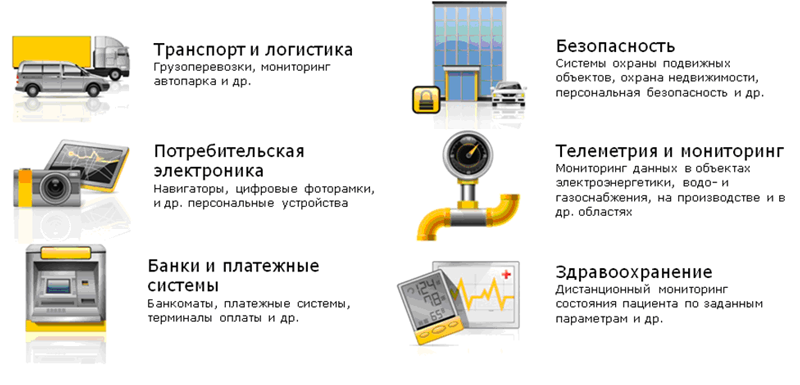
')
Why it is useful:
Generally speaking, a completely different type of subscriber is now entering the scene. You will not find new “live” subscribers in the cellular market already in the afternoon with fire - now, even in the remotest village, it is difficult to find people without a telephone. But the world of cars as users of mobile communications is only gaining momentum. Sim cards are already beginning to appear in sockets, cars, collars for dogs, so the world of SkyNet seems not so fantastic. Naturally, the operators reacted to such a change in the market and offered their solutions for working with M2M.
First of all, you need a handy tool for managing and monitoring SIM cards used in hardware. Any modern company should be able to manage their costs, including mobile communications. One of the most common problems in this area is the misuse of SIM cards. The company's task is to determine in a timely manner that the SIM card is used not for the needs of monitoring facilities, but for accessing the Internet from an unscrupulous employee’s mobile phone (for example, there was an example when they stole cards from M2M traffic lights). In fact, it is a question of controlling traffic and the cost of communications. In this vein, the system for monitoring SIM cards should provide information in real time so that the client receives online notifications about unauthorized actions from the SIM card or a sharp increase in traffic, which is not typical for this device. Plus, integrate it well with existing ERP and CRM systems.
A number of operators, such as Vodafone, Telenor, Orange, T-mobile, have developed their own management platforms, spending tens of millions of dollars and several years of work. Others, including AT & T, Telefonica, KPN, Rogers, O2, use partnerships from leading providers of M2M platforms and MVNO operators (Jasper Wireless, MainGate, ASPider, etc.) as part of partnership agreements. Such solutions are gradually beginning to appear in our country, and Beeline Business has become a pioneer on the Russian market in this area. In addition to the standard set of services, such as special M2M SIM cards (“thermal” and chips), Mobile VPN, IP, APN, the operator has been offering a special M2M product since the end of 2010 - “M2M Control Center”. The solution is implemented on the basis of the global platform Jasper Wireless, which is also used by AT & T, O2, KPN, TelCel, Rogers, etc. It allows client companies to independently manage their SIM cards.
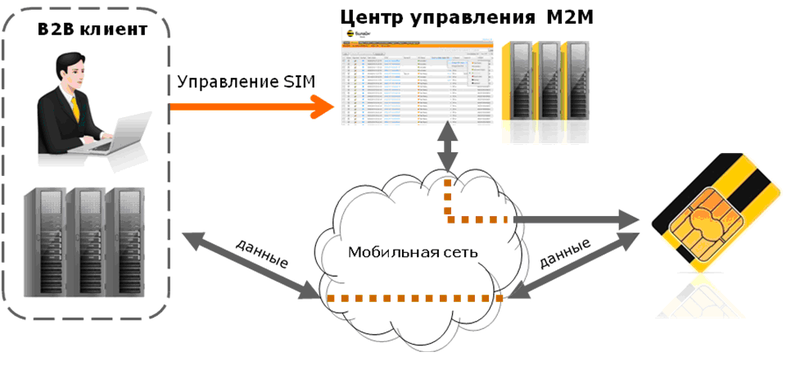
In essence, the platform on which the M2M Control Center product is based is a separate billing that is “sharpened” for working specifically with M2M SIM cards.
The most accurate rounding (rounded up to 1 Kb once a day), free intranet roaming throughout the country. It is possible to use a “common traffic pool”, which implies a “redistribution” of traffic packets between SIM cards. For example, if a subscriber has 10 SIM-cards with a tariff, the subscription fee of which includes 20 MB of traffic, then, using the “common pool”, the client will receive a packet of 200 MB of traffic that any SIM-card can use. An invoice is issued depending on the last connected TP (i.e., within a month you can switch between packages, tariffs and options as much as you like). If you can see that the traffic has been spent more than planned, you can simply change the tariff to more profitable. It is possible (and necessary) to set up an automatic change of tariffs for different values of SIM-card traffic.
The functionality is quite large: starting from the elementary functions of managing its SIMs, ending with the capabilities for setting up SIM-cards, “retail billing” and detailed information on the device operation (for example, which SGSN was used during a given period or what events occurred on the network).
For numbers connected to the M2M Control Center service, a separate numbering capacity is allocated in DEF codes 089 and 968. Using the DEF code 089 and a separate SMS Center dedicated specifically for this service gives a number of advantages - no extra messages will be sent to the client’s terminals It is impossible to send spam from short numbers, from external networks, etc. Thus, SMS will only go between the numbers connected to the service and directly between the SIM card and the platform. All SMS messages are displayed in the Control Center interface, in the same place you can see the delivery status and all detailed information about the SMS.
You can configure the status of the SIM card (active / blocked / ready for activation), change the set of services (for example, by disabling GPRS in roaming, connecting / disconnecting SMS and CSD, etc.), send an API command or notify the user by e-mail about the occurrence of a given event. You can program events and reactions: a change in billing or, for example, alerts: if the payment terminal, which has to raise the GPRS session for each new transaction, suddenly becomes too rarely go online, the user will be notified of the problem in a timely manner.
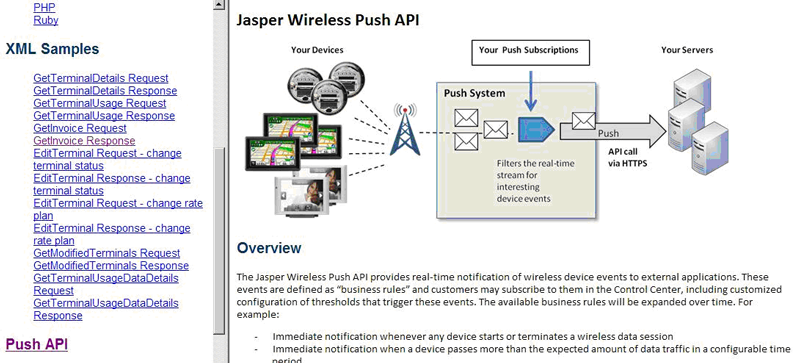
For differentiation of the rights of users to access the platform, there are different user roles that are changed by the client independently.
Functional Retail Billing allows for flexible account management. In general, the client receives from the operator one common bill for using the service. With the help of Retail Billing, you can break it up into several small accounts, which can, for example, help a large company to monitor the spending of funds by branches located in different regions. The client can also re-issue retail accounts to their internal users, create their retail rates. Ie, in fact, the client of the M2M Control Center can buy a SIM with a tariff with a certain cost of one MB from us, give it to its internal users / clients and assign its value MB, absolutely any.
On the platform, it is possible to create a dedicated APN access point for the client. This may be necessary if the client needs non-standard traffic routing, for example, so that all traffic from SIM-cards, bypassing the public Internet, goes through a dedicated channel directly to the client's server. Thus, the security of data transmission is significantly increased.
Using Mobile VPN helps solve a number of tasks:
There is a 2nd option to connect mobile Mobile VPN
1) Mobile VPN with a fixed-line operator
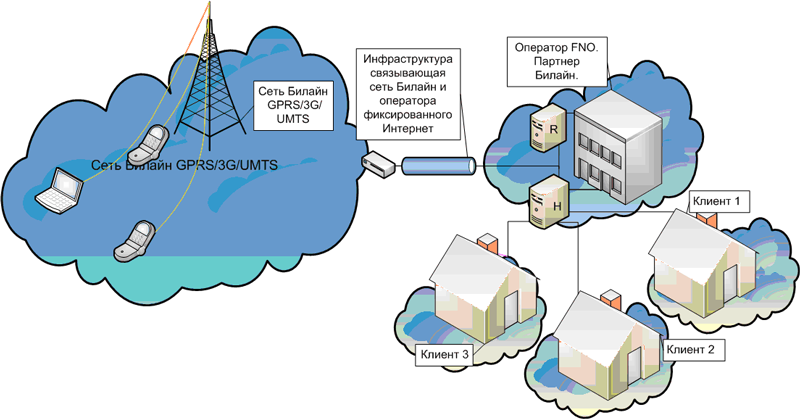
R - Radius-server, H - DHCP-server
VPN with FNO:
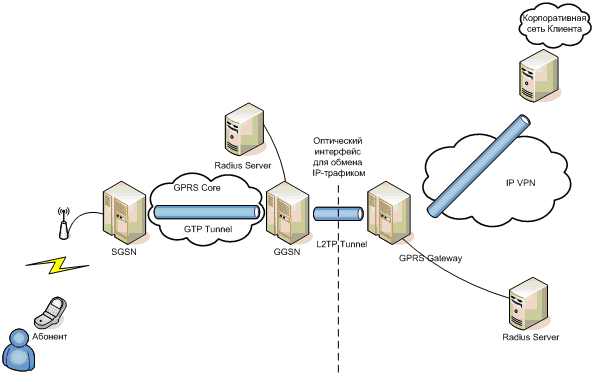
2) Mobile VPN without fixed line operator
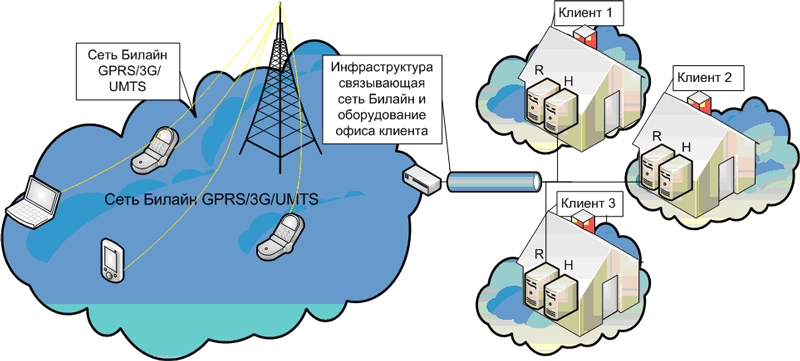
R - Radius-server, H - DHCP-server
Such a connection option is more convenient because there is no need to lay a fixed channel to the client, it is enough to have a broadband connection of the client’s office to the Internet. In this case, the VPN - router, LNS server, Radius server, DHCP server are located on the client side.
Having access to the platform interface, the user can monitor the status of all his SIM cards in real time. The built-in diagnostics system allows determining the real state of the SIM card, which in case of any problems will help determine at what stage the failure occurs. For example, having seen that everything is good from the operator, it can be concluded that the problem is with the end device and vice versa, not to send the repair team to the device (often remote or hard-to-reach), but to understand that the problem is on the operator’s side.

For more detailed diagnostics, the platform has the functionality of Spotlight, which allows you to determine on which SGSN and GGSN a SIM card is registered, view GPRS session parameters, see all attempts to activate PDP Context, network authorization attempts, sending SMS and delivery status, presence of “empty” sessions when no traffic was transmitted during a GPRS session (this may be normal device behavior, when it simply “holds” the session, but may indicate problems).
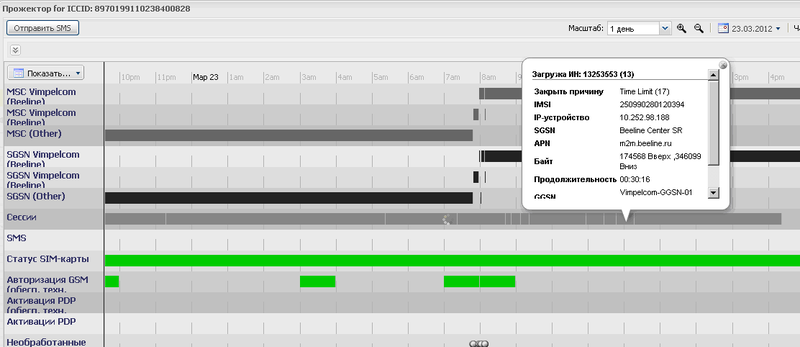
These smart machines have already lit up in a variety of areas, the number of which is growing every year:
- Banks and payment systems (solutions for connecting ATMs, payment terminals and other devices with the Customer’s corporate IT systems, other systems)
- Transport and logistics (solutions for monitoring the fleet, freight, urban and municipal transport, etc.)
- Security (fixed / mobile security solutions, video surveillance, etc.)
- Technological ACS of natural monopolies and industrial enterprises (energy, housing and utilities, etc.)
- Consumer electronics , vending and other industries.

')
Why it is useful:
- You can connect remotely almost anywhere, even when the cable to the place is almost impossible to hold. For example, in a house on top of a mountain or on a pipe with gas somewhere in the steppe.
- You can connect quickly and without laying infrastructure. For example - the security company can install sensors around the perimeter, without thinking about the cable.
- Such a connection is cheaper anyway, especially when used in a corporate environment.
Generally speaking, a completely different type of subscriber is now entering the scene. You will not find new “live” subscribers in the cellular market already in the afternoon with fire - now, even in the remotest village, it is difficult to find people without a telephone. But the world of cars as users of mobile communications is only gaining momentum. Sim cards are already beginning to appear in sockets, cars, collars for dogs, so the world of SkyNet seems not so fantastic. Naturally, the operators reacted to such a change in the market and offered their solutions for working with M2M.
What do you need from operators?
First of all, you need a handy tool for managing and monitoring SIM cards used in hardware. Any modern company should be able to manage their costs, including mobile communications. One of the most common problems in this area is the misuse of SIM cards. The company's task is to determine in a timely manner that the SIM card is used not for the needs of monitoring facilities, but for accessing the Internet from an unscrupulous employee’s mobile phone (for example, there was an example when they stole cards from M2M traffic lights). In fact, it is a question of controlling traffic and the cost of communications. In this vein, the system for monitoring SIM cards should provide information in real time so that the client receives online notifications about unauthorized actions from the SIM card or a sharp increase in traffic, which is not typical for this device. Plus, integrate it well with existing ERP and CRM systems.
A number of operators, such as Vodafone, Telenor, Orange, T-mobile, have developed their own management platforms, spending tens of millions of dollars and several years of work. Others, including AT & T, Telefonica, KPN, Rogers, O2, use partnerships from leading providers of M2M platforms and MVNO operators (Jasper Wireless, MainGate, ASPider, etc.) as part of partnership agreements. Such solutions are gradually beginning to appear in our country, and Beeline Business has become a pioneer on the Russian market in this area. In addition to the standard set of services, such as special M2M SIM cards (“thermal” and chips), Mobile VPN, IP, APN, the operator has been offering a special M2M product since the end of 2010 - “M2M Control Center”. The solution is implemented on the basis of the global platform Jasper Wireless, which is also used by AT & T, O2, KPN, TelCel, Rogers, etc. It allows client companies to independently manage their SIM cards.

How it works?
In essence, the platform on which the M2M Control Center product is based is a separate billing that is “sharpened” for working specifically with M2M SIM cards.
Billing
The most accurate rounding (rounded up to 1 Kb once a day), free intranet roaming throughout the country. It is possible to use a “common traffic pool”, which implies a “redistribution” of traffic packets between SIM cards. For example, if a subscriber has 10 SIM-cards with a tariff, the subscription fee of which includes 20 MB of traffic, then, using the “common pool”, the client will receive a packet of 200 MB of traffic that any SIM-card can use. An invoice is issued depending on the last connected TP (i.e., within a month you can switch between packages, tariffs and options as much as you like). If you can see that the traffic has been spent more than planned, you can simply change the tariff to more profitable. It is possible (and necessary) to set up an automatic change of tariffs for different values of SIM-card traffic.
Functional
The functionality is quite large: starting from the elementary functions of managing its SIMs, ending with the capabilities for setting up SIM-cards, “retail billing” and detailed information on the device operation (for example, which SGSN was used during a given period or what events occurred on the network).
For numbers connected to the M2M Control Center service, a separate numbering capacity is allocated in DEF codes 089 and 968. Using the DEF code 089 and a separate SMS Center dedicated specifically for this service gives a number of advantages - no extra messages will be sent to the client’s terminals It is impossible to send spam from short numbers, from external networks, etc. Thus, SMS will only go between the numbers connected to the service and directly between the SIM card and the platform. All SMS messages are displayed in the Control Center interface, in the same place you can see the delivery status and all detailed information about the SMS.
You can configure the status of the SIM card (active / blocked / ready for activation), change the set of services (for example, by disabling GPRS in roaming, connecting / disconnecting SMS and CSD, etc.), send an API command or notify the user by e-mail about the occurrence of a given event. You can program events and reactions: a change in billing or, for example, alerts: if the payment terminal, which has to raise the GPRS session for each new transaction, suddenly becomes too rarely go online, the user will be notified of the problem in a timely manner.

Access
For differentiation of the rights of users to access the platform, there are different user roles that are changed by the client independently.
Retail
Functional Retail Billing allows for flexible account management. In general, the client receives from the operator one common bill for using the service. With the help of Retail Billing, you can break it up into several small accounts, which can, for example, help a large company to monitor the spending of funds by branches located in different regions. The client can also re-issue retail accounts to their internal users, create their retail rates. Ie, in fact, the client of the M2M Control Center can buy a SIM with a tariff with a certain cost of one MB from us, give it to its internal users / clients and assign its value MB, absolutely any.
APN
On the platform, it is possible to create a dedicated APN access point for the client. This may be necessary if the client needs non-standard traffic routing, for example, so that all traffic from SIM-cards, bypassing the public Internet, goes through a dedicated channel directly to the client's server. Thus, the security of data transmission is significantly increased.
VPN
Using Mobile VPN helps solve a number of tasks:
- Access to corporate intranet site;
- Access to corporate email;
- Access to corporate databases and file resources;
- Access to corporate applications based on the TCP \ IP protocol;
- Secure connection of terminal equipment to the corporate network (POS terminals, ATMs, process equipment, 2, etc.);
- Providing "controlled" Internet access for company employees.
There is a 2nd option to connect mobile Mobile VPN
1) Mobile VPN with a fixed-line operator

R - Radius-server, H - DHCP-server
VPN with FNO:

2) Mobile VPN without fixed line operator

R - Radius-server, H - DHCP-server
Such a connection option is more convenient because there is no need to lay a fixed channel to the client, it is enough to have a broadband connection of the client’s office to the Internet. In this case, the VPN - router, LNS server, Radius server, DHCP server are located on the client side.
Monitoring
Having access to the platform interface, the user can monitor the status of all his SIM cards in real time. The built-in diagnostics system allows determining the real state of the SIM card, which in case of any problems will help determine at what stage the failure occurs. For example, having seen that everything is good from the operator, it can be concluded that the problem is with the end device and vice versa, not to send the repair team to the device (often remote or hard-to-reach), but to understand that the problem is on the operator’s side.

For more detailed diagnostics, the platform has the functionality of Spotlight, which allows you to determine on which SGSN and GGSN a SIM card is registered, view GPRS session parameters, see all attempts to activate PDP Context, network authorization attempts, sending SMS and delivery status, presence of “empty” sessions when no traffic was transmitted during a GPRS session (this may be normal device behavior, when it simply “holds” the session, but may indicate problems).

Source: https://habr.com/ru/post/145423/
All Articles